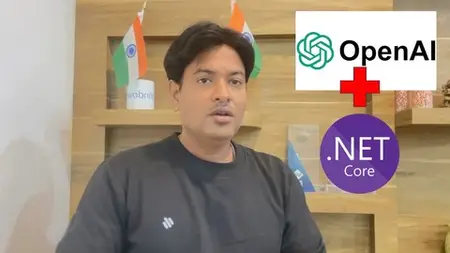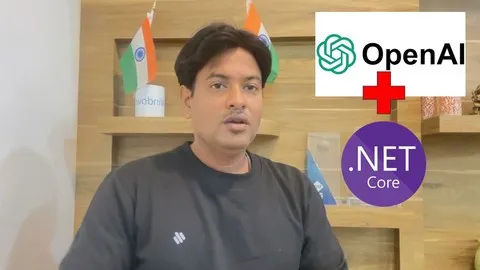.Net 9 With Openai Complete Guide With Real Time Project
Published 11/2024
MP4 | Video: h264, 1920x1080 | Audio: AAC, 44.1 KHz
Language: English | Size: 634.07 MB | Duration: 1h 23m
Published 11/2024
MP4 | Video: h264, 1920x1080 | Audio: AAC, 44.1 KHz
Language: English | Size: 634.07 MB | Duration: 1h 23m
Chat Service , Image Service etc
What you'll learn
Introduction about Open AI , How to Integrate OpenAI in ASP. NET 9 Application. How to Generate Open API Keys from Official website. How to use abstract classe
How to use new abstract classes in .NET 9 for AI Service like Microsoft extension AI interface, use chat based prompt for seraching data from list or in-memory
How to generate chat based AI Images, its taking too much token so carefully to use gpt-40-mini model and ollama model. How many models are existing in Open AI
Text to Audio and Vice versa model are also existing but in this project we will work on wisper model. also work on DALL-E 2 model. How to generate Dashboard
Requirements
You need to know basics of Object Oriented Programming and MVC knowledge and
Description
Introduction to OpenAI and ASP.NET Core 9Key Models and Capabilities Provided by OpenAIWhy Use OpenAI with ASP.NET Core 9? Benefits of Integrating AI Capabilities in Web ApplicationsSetup Requirements: Understanding How OpenAI API Works, Including Obtaining API Keys and AuthenticationMaking Text Requests to OpenAICreating Chat-Based Applications: Sending prompts to the API and generating text (simple Q&A bot, content generation, etc.).Using IChatCompletionService: Integrating OpenAI's chat completion models like GPT-4 into your ASP.NET application.Displaying AI-generated results: Rendering the output in an MVC view. Handling Advanced Text Generation TasksText summarization: Using OpenAI for summarizing large pieces of text.Text Classification: Sending data for text classification tasks.Sentiment Analysis: Analyzing the sentiment of user-submitted text using OpenAI.Generating Structured Data (Tables): Asking OpenAI to return results in specific formats (e.g., HTML tables, JSON). Image Handling and Generation with OpenAIIntroduction to DALL·E: Understanding how OpenAI’s DALL·E model can generate images based on text descriptions.Integrating Image Generation: Using the OpenAI API to generate images (like product images or artwork) in response to queries.Image Upload and Analysis: Sending images to OpenAI for analysis (multimodal queries like GPT-4 Vision). Dynamic Responses Based on User InputUnderstanding Dynamic Responses: Crafting prompts that request specific, structured responses from OpenAI.Creating Custom AI Responses: Handling a variety of user queries dynamically (e.g., sales data, trend analysis).Generating HTML from OpenAI: Instructing OpenAI to generate HTML (tables, charts) in response to queries.Using AI to Generate Structured Content: Formatting AI’s response into structured data, like HTML or CSV.Managing Large Datasets with OpenAIChunking large datasets: Dividing data into chunks and sending it to OpenAI for processing.Efficient Querying and Summarization: Using OpenAI’s model to analyze large datasets in smaller, manageable pieces.Integrating OpenAI with Databases: Querying data from an SQL database (e.g., sales data) and passing it to OpenAI for processing.Caching and Optimizing OpenAI RequestsMinimizing OpenAI API Calls: Implementing caching for frequently asked queries to avoid redundant API requests.Storing Results Locally: Caching OpenAI responses in memory or a database.Using In-memory Data: Optimizing response times by calculating results in-memory before asking OpenAI for more complex analysis.Handling File Uploads (Images, CSV) with OpenAIUploading and Processing Files: Allowing users to upload images or CSV files and sending the data to OpenAI for analysis.Image and Document Analysis: Using OpenAI to analyze files (e.g., extracting text from an image or generating insights from CSV data).Storing Uploaded Files Temporarily: How to handle large file uploads and process them efficiently. Real-Time Application: Building a Chatbot with OpenAIIntegrating OpenAI into a Chatbot: Building a chatbot that responds to user queries using OpenAI’s models.Handling Multi-turn Conversations: Maintaining state across multiple interactions with OpenAI to make conversations more natural.Customizing the Chatbot’s Behavior: Tweaking the AI’s personality, responses, and behavior according to user needs.Security ConsiderationsSecuring OpenAI API Keys: Properly securing API keys using environment variables or secret management services.Rate Limiting: Handling rate limiting by OpenAI’s API to avoid hitting request limits.User Data Privacy: Ensuring that user input and any sensitive data are securely managed.
Overview
Section 1: Introduction
Lecture 1 Introduction about OpenAI
Lecture 2 Configure AI using Open AI Api Key and .NET 9 nuget Packages
Lecture 3 First AI Demo and Why we use it with ASP.NET 9
Section 2: How to register AI Models in Program File
Lecture 4 Register AI Models in Program File
Section 3: Test Open AI Model
Lecture 5 Sales Data Entity
Lecture 6 Design View Interface for your AI Project
Lecture 7 Prepare Chat App Functionality
Section 4: Test Model for Object Detection in Image
Lecture 8 Prepare views for Object Detection
Lecture 9 Controller Functionality for Object Detection
Section 5: Generate Chat based AI Images
Lecture 10 Change AI Model
Lecture 11 Image Generation Service Class
Lecture 12 Image Generate View or UI
Lecture 13 Functionality for Image Generation
Lecture 14 Course code the project
Beginners to Advanced Level



